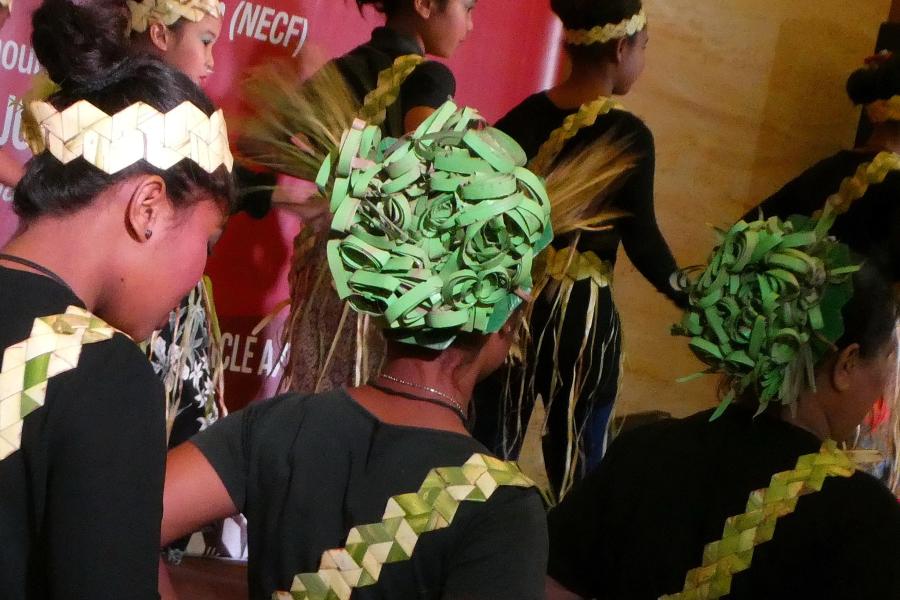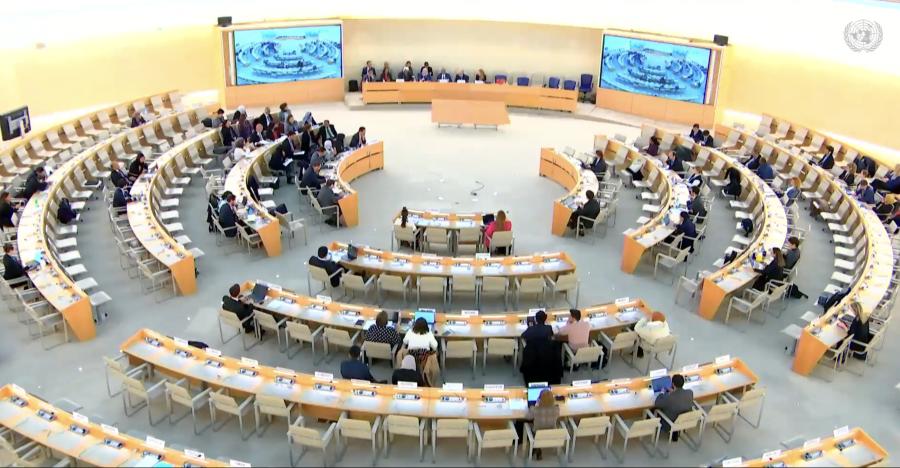Batek Negritos from the vicinity of Taman Negara National Park in West Malaysia are a hunting and gathering people presently experiencing rapid encroachment by the modern world. Under the authority of the Malaysian government, they are being encouraged to settle and to emulate Malay subsistence farming communities. Unfortunately, this strategy has had a number of adverse effects on the Batek.
Traditionally, Batek subsisted primarily on gathered tubers. Fruit, leaves, shoots, fish, and small game such as monkeys contributed to their diet. More recently, the addition of cash to their economy has led to a decreased utilization of wild food sources and an increased dependence on commercial foods such as rice, sugar, tinned sardines, biscuits and tea. Collected food, however, continues to play an important role, and its availability strongly affects the Batek's movements through the jungle.
Rivers and streams also play an important role in Batek life. They provide water, fish, a place to bathe and natural territorial boundaries. The Batek prefer to camp in the vicinity of a stream or river. When an individual is asked where he or she is from, they usually say that they are from the confluence of particular rivers or streams.
Although watershed territories are not owned and allegiance to them is not owed, a feeling of homeland is, nonetheless, associated with these culturally and physically demarcated areas. Each of these tracts is exploited by a closely-knit residential group. In affairs involving non-Batek, each group, in turn, is represented by a headman. Charisma, extroversion, and a familiarity with the Malay language are the basic qualifications for the position, but generally an individual becomes headman because others are reluctant to interact with outsiders.
Taman Negara, established in 1939, is Malaysia's oldest national park. Situated in the interior of the Malay Peninsula, it contains 1,300 km of primary jungle. In the late 1960s, tourism to Taman Negara began to increase steadily. This led to the Batek's interest in obtaining work as jungle guides at Kuala Tahan.
Malaysian Government Pressures the Batek to Settle
In 1979, the Malaysian government began to pressure the Batek to relocate at a government-subsidized settlement established at Kuala Atok, just outside the park boundaries. Several factors encouraged the government to create this agricultural community. Their primary concern was the notion that if the Batek were left to continue their semi-nomadic existence, they would come into contact with communist terrorists hiding in the jungle and be forced to give them economic and intelligence assistance. During the communist threat of 1948-1960 (the "Emergency"), many aboriginal groups aided the communists. The government also hoped, through the sedentization program, to increase the population of Bumiputera, "sons of the soil." This is in line with their policy of integrating Aboriginal people into Malay Society.
A less immediate but equally important goal of the development project was to encourage the Batek to give up their semi-nomadic existence, perceived by the authorities as primitive. Another goal was simply to remove the Batek from Taman Negara, where collecting and selling jungle produce - one of their main economic activities - did not conform to park regulations.
The way in which the location of the settlement at Kuala Atok was determined sheds light on Batek values and how they conflict with those of government officials. When the Bureau of Aboriginal Affairs (Jabatan Hal Ehwal Orang Asli) first approached the Batek with the relocation plan in 1979, the headman expressed his strong disapproval. Government authorities suggested that the settlement be placed on the south bank of the Tembeling River, close to Kuala Tahan. They felt that this would be a suitable location for the Batek to relocate since it was outside the park boundaries, but not an unknown region to the Batek. Despite the apparent desirability of the settlement being located close to Kuala Tahan, the park headquarters, Batek traditions make it inappropriate for them to live there. To the Batek, the land north of the Tembeling River is ancestral land, while the land south of the river is territory for which they have no affinity. In spite of the headman's strong disapproval, the group was moved to the new site.
Relocation at Kuala Atok
At Kuala Atok, ten wooden houses with corrugated tin roofs were constructed for the Batek. A more substantial house was built for the Malay field officer. In an initial effort to promote agriculture, the government provided cuttings, tools, and training. Theoretically, the Malay field officer was to encourage cultivation and advise the community.
Now, five years since their construction, many of the houses at Kuala Atok are without their original sidings. There is no evidence of food crops except for two papaya trees, a mango tree, several banana trees, and a few eggplant bushes. According to the park ranger, who is stationed about ¼ mile upriver, when the field officer went away, the Batek generally left the settlement. Even when he was in residence, the Batek were often gone.
The government delivers food rations once every six weeks, but shortages are common. The Batek feel that the settlement is unbearably hot, and that people who stay there too long become sick. The Batek do spend some time at Kuala Atok, however, since periodic residence is necessary in order to get the food rations that the government delivers. But once the rations have been consumed, the Batek pack up their few personal belongings and move to a more comfortable location, generally within the park boundaries and closer to wild foods and wage labor.
Kuala Atok Disrupts Batek's Lives
The construction of the Batek's homes at Kuala Atok alone illustrates the great difference between Batek patterns of residence, and those devised for them by the government. A survey of abandoned campsites within the park indicated that closely situated, inward-facing shelters constitute the preferred Batek residential space. The dwellings at Kuala Atok, however, are in a line on the top of a bluff overlooking the Tembeling River. While the traditional Batek camps are sheltered by a thick jungle canopy, the Kuala Atok houses are in a large, unshaded clearing.
In October 1984, a large Batek camp was situated at the confluence of the Yong and Tembeling Rivers. Numerous Batek felt that this camp was much cooler and healthier than the Kuala Atok settlement. In addition, several of the Batek men were able to obtain work at a nearby Malay village carrying bags of cement to the construction site of a school.
Until recently one of the Batek's main sources of income was jungle-guiding. Initially, competition for this work was nonexistent. However, as local Malays obtained experience as trail guides, the Batek found they no longer had a monopoly. A tourist pamphlet published by the national park states that the Batek "now spend most of their time in settlements outside the Park boundary at...Kuala Atok, where the government has provided land for them to cultivate. They now rarely work as guides...and this work is being taken over by Malay guides from Kuala Tahan." Clearly, the forced move to Kuala Atok has made it even more difficult for the Batek to obtain guiding jobs.
The Batek repeatedly express their dissatisfaction with this state of affairs. Guiding, which pays approximately US$15 per day, is the most lucrative short-term work available. The Batek feel that they are being pushed out by Malays whose villages lie adjacent to the park headquarters.
The collection and sale of jungle produce, another important economic activity for the Batek, has also been curtailed in recent years. In accordance with park regulations, jungle produce such as resin or rattan may not be collected for sale. In spite of the law, the Batek continue to collect plant materials from within Taman Negara and to sell them to local Malays as they have since at least the 1950s. Park officials are aware that the Batek occasionally engage in this activity, but because of its infrequency no measures are generally taken against them.
Wage-labor - not agriculture - is the most desirable economic option for the Batek since it is better suited to their traditional lifestyle. Unlike agriculture, which involves a heavy investment of time and energy before the results may be enjoyed, wage-labor involves same-day payment with the end of the work period in sight.
By engaging in temporary wage-labor, Batek men can take advantage of available work while other members of the group exploit wild food resources. The preference for wage-labor over farming indicates that the Batek are unprepared to give up fundamental characteristics of their culture, such as mobility and opportunism.
Wage labor, nonetheless, affects the Batek's patterns of social organization and cultural orientation. For example, contrary to their traditionally flexible division of labor, the wage work is open primarily to men. Another example of the split between traditional and new ways is vividly apparent in how gathered and bought foods are distributed: collected foods are shared among all members of the group, while packaged foods are consumed by the immediate family only.
The failure of Kuala Atok as a vital and productive community is testimony to the drastic changes that would have to be made by the Batek in order to accommodate an agricultural life. Their hunting and gathering heritage makes the prospect of permanent and successful settlement largely impossible at this time.
Over the years, the Batek of Taman Negara have been finding solutions to the problems of encroachment by the modern world. In the interest of maintaining mobility and flexibility, they have become petty entrepreneurs rather than subsistence farmers. Current governmental policies, however, are makin economic self-sufficiency harder to achieve. The inclination toward wage-labor suggests that the Batek are changing only as much as they must in order to maintain important elements of their culture.
The removal of the Batek from their traditional homeland, combined with the lack of viable economic alternatives, places them in a tenuous position. Like indigenous peoples elsewhere, the Batek should be able to enjoy the benefits of development. They should be allowed to make their own decisions regarding subsistence strategies, relocation, and integration into the larger Malaysian society. Above all, the Batek should be allowed, if they so desire, to continue their hunting and gathering existence within their ancestral territory.
Article copyright Cultural Survival, Inc.


